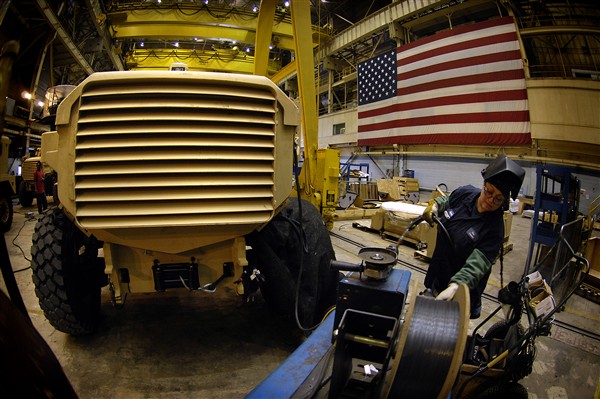
The foundation is aiming to increase the number of high wage jobs.
The Century Foundation officially launched a new initiative on Tuesday to find ways to bring high wage work back to America’s heartland, including via manufacturing, technological innovation, expanding workforce training and targeted investment.
Overseen by the foundation’s Bernard L. Schwartz Rediscovering Government Initiative, the "High Wage America Project” will focus on research and policy solutions to develop a high wage agenda and reverse policies that cut wages. The project kicked off with a discussion at the Capitol in Washington, D.C., featuring Members of Congress and panelists from different regions of the country.
The project believes that good opportunities can be restored, and that all Americans — from the industrial heartland to the inner city — can lead better lives. Its agenda has three major components to help workers:
- Public investment and innovation;
- Education and training;
- And labor standards and social supports.
The Century Foundation also released a new report this week, titled Why Manufacturing Jobs Are Worth Saving, that studies the role of manufacturing in our economy, its potential for growth and its track record of providing above-average wages.
Authors Andrew Stettner, Joel S. Yudken and Michael McCormack note that the “steep decline of U.S. manufacturing during the first decade of the century was the result of changes in trade policy not automation.” But given manufacturing’s growth over the past several years — the sector gained 945,000 jobs from 2010 to 2017 — a major revival is now possible. Manufacturing remains hugely important to Midwestern states and rural communities, and if lawmakers and others make smart decisions, continued growth can happen.
“As the nation’s manufacturing workforce ages and technical demands of jobs increase, there will be an acute need to create a diverse pipeline of skilled workers and entry-level workers interested in manufacturing careers,” they write. “Taking advantage of this opportunity will require a dynamic, high road recovery model—one that will address the interlinked challenges of manufacturing innovation and workforce readiness, and ensure that federal policies level the playing field for U.S. producers.”
Insights from Capitol Hill
During the kickoff event on Capitol Hill, Rep. Marcy Kaptur (D) reiterated the importance of the smart manufacturing policies in places like her home state of Ohio, where she calls manufacturing their lifeblood. “We need to respect it and we need to enliven it,” Kaptur said of manufacturing.
Kaptur noted that the trade deficit is felt most by manufacturing workers, who in some cases are forced to train the very people their outsourced jobs go to. "We must hold this administration accountable for promises they made in places like Ohio" to fix these kinds of problems, Kaptur added.
Kaptur described plans to renegotiate the North American Free Trade Agreement (NAFTA) as an opportunity to fix problems related to unfair trade, as well as set an example for all future trade deals to ensure fairness.
She also advocated for passage of the Balancing of Trade Act of 2017, legislation she introduced to require that the president take steps to better balance trade with countries that the United States has maintained an annual trade deficit of more than $10 billion for three consecutive years.
The congresswoman also urged the Commerce Department to finish its Section 232 national security investigations into steel, which should be unveiled by the end of June. Kaptur also emphasized the importance of thinking creatively to reboot the economy and the manufacturing sector, including things such as providing bridge loans to the steel industry, and reinvesting back into our industrial base.
Pennsylvania Sen. Bob Casey (D) made an appearance on Tuesday as well, noting that wage growth in America has been at an all-time low, 11 percent, for the past 40 years. Growth from 1948 to 1972 hit 91 percent, he added.
Casey also advocated for the Community Economic Assistance Act, legislation he introduced to provide economic assistance to communities that have experienced a localized recession from large scale job loss. The communities that would eligible for the assistance are small rural towns that have been effected by jobs moving overseas.
Amy Goldstein, author of Janesville: An American Story, also led a discussion panel featuring three panelists who answered questions on why manufacturing jobs are worth saving and what can be improved.
Stettner, a senior fellow at The Century Foundation who helped author the new manufacturing report, summarized the recovery of manufacturing jobs since 2010 and noted that small cities and towns rely on manufacturing for a good portion of their jobs. While some manufacturing jobs have been recovered, he did summarize a few challenges that face the industry, including recruiting women and minority workers, coping with advancements in technology, and decreasing wages.
Madeline Janis, executive director of the Jobs to Move America project, also highlighted the lack of representation for women in manufacturing. According to Janis, just 27 percent of manufacturing jobs belong to women — most of which are administrative positions. Only 7 percent of middle-skilled manufacturing positions are held by women.
This blog post was written by AAM interns Kami Demirag, Erica Maddox and Megan Salrin.
